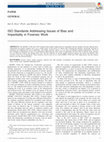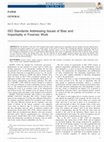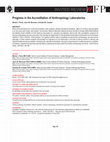Conference Presentations by Michal Pierce
AAFS, 2016
After attending this presentation, attendees will: (1) understand the choices available for foren... more After attending this presentation, attendees will: (1) understand the choices available for forensic agency accreditation and the differences between ISO 17025 and ISO 17020; and, (2) learn the challenges faced by professionals practicing forensic anthropology when striving to have their facilities, procedures, and casework meet ISO 17020 standards.
AAFS, 2017
After attending this presentation, attendees will understand the difference between blind testing... more After attending this presentation, attendees will understand the difference between blind testing and verification, know the challenges faced by quality assurance personnel when attempting to administer blind proficiency testing to laboratory staff, and be equipped with a variety of options for resolving problems that may accompany blind test preparation. This presentation will impact the forensic science community by discussing the feasibility of successfully incorporating blind proficiency testing and verification into the quality assurance programs of crime laboratories, thereby suggesting ways to increase the confidence in overall laboratory performance.
International Forensics Symposium on Error Management, 2015
As documentation for labor ator y functions becomes more automated and paperless, the need for co... more As documentation for labor ator y functions becomes more automated and paperless, the need for computer programs and templates to be properly validated before use is unquestionable. Problems can arise if IT personnel do not successfully capture the scope of forensic validation. Even when computer-savvy lab analysts attempt to validate these programs, there can be a gap in ensuring the software is tested sufficiently to avert a series of errors. One error in a laboratory software program can cause multiple errors in released reports.

After attending this presentation, attendees will have a better understanding of the recent effor... more After attending this presentation, attendees will have a better understanding of the recent efforts undertaken at the Harris County Institute of Forensic Sciences (HCIFS) to address the pertinent issue of establishing a validation program and Standard Operating Procedures (SOPs) for anthropological equipment and software, specifically the MicroScribe® 3D digitizer and the 3Skull and FORDISC software programs used to collect and analyze osteometric data.
This presentation will impact the forensic science community by providing best practices to mitigate potential issues of method and measurement error. The present research will illustrate the significance of validating anthropological equipment in every laboratory as a quality assurance measure, notwithstanding its general acceptance within the forensic anthropological community.
Establishing a quality assurance program and achieving laboratory accreditation has become paramount for forensic anthropology. It is through these processes that the field of forensic anthropology can demonstrate the level of surety associated with anthropological analyses. In August 2015, the HCIFS’s Forensic Anthropology Division (FAD) became the first forensic anthropology laboratory to be accredited under ANAB’s ISO/IEC 17020 inspection body program. One challenge posed during the accreditation process was answering the question, “Do validation, verification, and performance checks of anthropological methods and activities follow a written procedure?”
Equipment and software programs including the digitizer, mandibulometer, 3Skull, and FORDISC, were in use prior to accreditation. Their use and data were assumed to be reliable since members of the forensic anthropology community deem them acceptable and references for their functionality are available in peer-reviewed literature. However, no internal validations were performed when the equipment and software were received. Plans were made to collaborate with the HCIFS’s Quality Management Division (QMD) to properly validate the equipment and software in order to meet accreditation standards. All accredited laboratories, per ANAB’s Guidance on Uncertainty for Testing Laboratories, must review significant factors that may contribute to the error or variability in measurements. Thus, accreditation standards require in-house validations for analytical equipment to demonstrate the level of surety associated with analyses.
To perform the internal validation of the digitizer, a reference standard was created by selecting an anatomical skull and pre-marking the osteometric landmarks. The elements were measured using calipers and standard collection protocols. Then the analysts collected the landmarks following the newly-written digitizer SOP, checked that the coordinates were accurately captured in the 3Skull software, and compared the output to the caliper-derived measurements. In the course of establishing this procedure, measurement uncertainty calculations for 35 interlandmark distances (IDLs) and one angle, were performed using Root Sum Squared (RSS) and following the NIST procedure for measurement uncertainty.
For the in-house FORDISC validation, cranial and postcranial metric data were collected from four known, donated specimens typical of the Black and White groups within the Forensic Databank by one author (KS). These data were processed through FORDISC, retaining a log of the osteometric measurements used and analytical iterations. The IDLs were then provided to the FAD analysts who entered them into FORDISC without viewing KS’s results. Validation was considered successful when the FAD FORDISC classification results were reasonably similar to those of KS when comparable analytical iterations were employed. While the FAD’s equipment and software validation SOP is specific to the MicroScribe, 3Skull, and FORDISC, forensic anthropologists will be able to identify the important elements that should be included in any anthropology software program validation (i.e., 3D-ID, (hu)MANid, Macromorphoscopics) or software update.
Formalizing a process for internal validation to the point where instructions can be documented in SOPs may seem unnecessary to practitioners, especially if anthropologists believe they are already employing validated methods/equipment. However, in-house verification is warranted to guarantee the appropriateness of their use for fulfilling the service needs of the laboratory. The goal is to advance analyses towards uniformity and higher quality. While this may be challenging for laboratories with only one forensic anthropologist, or offices without a QMD, validation, verification, and performance checks for your equipment in your laboratory is vital in this era of forensic science critique. Therefore, one of the primary deliverables for this project is the availability of the HCIFS’s equipment and software validation plans and SOPs which can be used as a template to meet the needs of any forensic anthropology laboratory.
Papers by Michal Pierce

Social Science Research Network, 2019
The ISO/IEC 17020 and 17025 standards both include requirements for impartiality and the freedom ... more The ISO/IEC 17020 and 17025 standards both include requirements for impartiality and the freedom from bias. Meeting these requirements for implicit cognitive bias is not a simple matter. In this article, we address these international standards, specifically focusing on evaluating and mitigating the risk to impartiality, and quality assurance checks, so as to meet accreditation program requirements. We cover their meaning to management as well as to practitioners, addressing how these issues of impartiality and bias relate to forensic work, and how one can effectively evaluate and mitigate those risks. We then elaborate on specific quality assurance policies and checks and identify when corrective action may be appropriate. These measures will not only serve to meet ISO/IEC 17020 and 17025 requirements, but also enhance forensic work and decision-making.

Journal of Forensic Sciences, Dec 30, 2019
The ISO/IEC 17020 and 17025 standards both include requirements for impartiality and the freedom ... more The ISO/IEC 17020 and 17025 standards both include requirements for impartiality and the freedom from bias. Meeting these requirements for implicit cognitive bias is not a simple matter. In this article, we address these international standards, specifically focusing on evaluating and mitigating the risk to impartiality, and quality assurance checks, so as to meet accreditation program requirements. We cover their meaning to management as well as to practitioners, addressing how these issues of impartiality and bias relate to forensic work, and how one can effectively evaluate and mitigate those risks. We then elaborate on specific quality assurance policies and checks and identify when corrective action may be appropriate. These measures will not only serve to meet ISO/IEC 17020 and 17025 requirements, but also enhance forensic work and decision-making.
Forensic anthropology, Dec 7, 2020

The quest for transparency in the forensic sciences is guided by robust quality assurance (QA) pr... more The quest for transparency in the forensic sciences is guided by robust quality assurance (QA) programs; however, antiquated ideas of what QA is and how it is applied is a roadblock for many laboratories. First, all forensic disciplines must abandon the “old school” thinking that QA only pertains to the hard sciences and therefore exists exclusively in the crime laboratory. This is a fallacy. All fields need and benefit from QA. We must now see modern QA for what it is today – a positive, proactive way of thinking, instead of a simple means for rigidly defining conformity. Secondly, the forensic disciplines must recognize the difference between quality control (QC, QA), and quality management (QM). QC focuses on testing the conformity of a product or service, while QA ensures that processes are conducive for generating a quality product or service. QM is broader and involves the planning and policy-making of top management to support QC, QA, and quality improvement initiatives. Implementation of a QA program is more challenging in forensic anthropology compared with other forensic disciplines, such as toxicology and genetics. The latter disciplines have more technical equipment and automated processes, which are easier to regulate and controlwithin a laboratory setting. Forensic Anthropologists, however, must contend with the ultimate nonstandardized data: human variation. Characterizing and evaluating human variation often lends itself to more subjective methods. Thus, the challenges associated with qualifying and quantifying human variation set anthropology apart from the other hard sciences. A robust quality program provides a layer of checks and controls to assist with the standardization of procedures.

Academic forensic pathology, Sep 1, 2016
While crime laboratories are commonly accredited under programs utilizing international standards... more While crime laboratories are commonly accredited under programs utilizing international standards, options for forensic anthropologists to do the same were limited, until recently. The American National Standards Institute-American Society for Quality (ANSI-ASQ) National Accreditation Board (ANAB) and the American Association for Laboratory Accreditation (A2LA) both offer accreditation programs for forensic anthropology services using either the International Organization for Standardization/International Electrotechnical Commission (ISO/IEC) 17025 or ISO/IEC 17020 standard. The significant efforts made to specifically include forensic anthropology, and also forensic pathology, in these national programs demonstrate the importance for all practitioners in the field of forensic science to develop and maintain quality assurance programs consistent with international standards. Among the requirements for quality assurance is validation of methods, a practice that was previously identified as needing improvement within the forensic anthropology community.
Journal of Forensic Nursing, Oct 5, 2020
Standard operating procedures drive everyday practice within any organization, including those wi... more Standard operating procedures drive everyday practice within any organization, including those within a forensic setting. In the event of unusual circumstances, organizations must respond rapidly to address the impact on operations while ensuring that the quality and safety outcomes of routine services are not affected. This case study illustrates how standard operating procedures can be newly developed or modified, and rapidly deployed and quickly revised, to address unusual circumstances. The response to the COVID-19 pandemic is used as an example in this case report.
Disaster Victim Identification in the 21st Century
Forensic Anthropology, Dec 7, 2020

Medicolegal death investigation is the process of determining and reporting the cause and manner ... more Medicolegal death investigation is the process of determining and reporting the cause and manner of death for unexpected fatalities. This process involves activities at the death scene, in the morgue and in the forensic laboratory. Careful management of evidence, including the body of the deceased is imperative to the success of the process. There is significant local and state variability in the medicolegal process but temporary possession of the deceased person(s) and associated evidence and personal effects, and transport of the decedent for postmortem examination are generally part of the process. While in the possession of the medicolegal authority, items of evidence may be separated from the body itself for laboratory testing (i.e. blood and tissue specimens, trace evidence), for analysis by subject matter experts (i.e. bone, insect specimens), or for archiving of items that may or may not inform the cause or manner of death (i.e. property or clothing items). The effectiveness of the process by which a jurisdiction acquires and possesses these items of evidence and maintains their provenience through the entire process impacts the success of the overall investigation. In addition to cause and manner of death certification, identification of previously unidentified decedents, and maintenance of the identification of those whose identity is known is a core component of the medicolegal death investigation process. The circumstances of unexpected deaths often separate decedents from identifying information and the medicolegal death investigator is often left with no prior knowledge of a deceased person’s identity. For these reasons, it is best practice to manage a deceased body as an item of evidence and to apply evidence management principles throughout the medicolegal process, from retrieval of the decedent from the death scene, to storage prior to and after examination, during the postmortem examination and during release of the decedent to family. This chapter describes evidence management best practices for the medicolegal investigation of individual fatalities as well as multiple/mass fatality incidents. The best practices described pertain to evidence collected by death scene investigators (MLDI), forensic pathologists, forensic anthropologists, forensic entomologists, forensic laboratory personnel and the application of these best practices in both daily medicolegal death investigations and in the multiple/mass fatality context. The article first provides a basic overview of the death investigation system in the United States and the degree to which death investigation varies from place to place. This overview is followed by an explanation of the concept of the human body or parts of the human body as evidence and the advantages of such a strategy.

Journal of Forensic Sciences, 2020
Blind proficiency testing is ideal for testing crime laboratory personnel because the elements of... more Blind proficiency testing is ideal for testing crime laboratory personnel because the elements of analyst bias and anticipation are removed. However, sending proficiency tests through the laboratory system as real casework is difficult. The substantial challenges with preparing and administering blind tests may prevent laboratory managers from initiating blind testing. In 2015, the Harris County Institute of Forensic Sciences committed to improving its crime laboratory’s proficiency testing program by adding blind tests. The goal was to test the whole system, from evidence receipt to report release. With careful planning, trial‐and‐error, and ongoing assessment of available resources, not only was the program proven to be feasible, but there was also clear understanding of how to optimize our program. In this article, we share our experiences, lessons learned, and program details to assist other forensic service providers with developing their own blind testing programs, which would ultimately lead to improved quality assurance.

SSRN Electronic Journal, 2019
The ISO/IEC 17020 and 17025 standards both include requirements for impartiality and the freedom ... more The ISO/IEC 17020 and 17025 standards both include requirements for impartiality and the freedom from bias. Meeting these requirements for implicit cognitive bias is not a simple matter. In this article, we address these international standards, specifically focusing on evaluating and mitigating the risk to impartiality, and quality assurance checks, so as to meet accreditation program requirements. We cover their meaning to management as well as to practitioners, addressing how these issues of impartiality and bias relate to forensic work, and how one can effectively evaluate and mitigate those risks. We then elaborate on specific quality assurance policies and checks and identify when corrective action may be appropriate. These measures will not only serve to meet ISO/IEC 17020 and 17025 requirements, but also enhance forensic work and decision‐making.

Forensic Anthropology and the United States Judicial System, 2019
The quest for transparency in the forensic sciences is guided by robust quality assurance (QA) pr... more The quest for transparency in the forensic sciences is guided by robust quality assurance (QA) programs; however, antiquated ideas of what QA is and how it is applied is a roadblock for many laboratories. First, all forensic disciplines must abandon the “old school” thinking that QA only pertains to the hard sciences and therefore exists exclusively in the crime laboratory. This is a fallacy. All fields need and benefit from QA. We must now see modern QA for what it is today – a positive, proactive way of thinking, instead of a simple means for rigidly defining conformity. Secondly, the forensic disciplines must recognize the difference between quality control (QC, QA), and quality management (QM). QC focuses on testing the conformity of a product or service, while QA ensures that processes are conducive for generating a quality product or service. QM is broader and involves the planning and policy-making of top management to support QC, QA, and quality improvement initiatives. Implementation of a QA program is more challenging in forensic anthropology compared with other forensic disciplines, such as toxicology and genetics. The latter disciplines have more technical equipment and automated processes, which are easier to regulate and controlwithin a laboratory setting. Forensic Anthropologists, however, must contend with the ultimate nonstandardized data: human variation. Characterizing and evaluating human variation often lends itself to more subjective methods. Thus, the challenges associated with qualifying and quantifying human variation set anthropology apart from the other hard sciences. A robust quality program provides a layer of checks and controls to assist with the standardization of procedures.

Academic Forensic Pathology, 2016
While crime laboratories are commonly accredited under programs utilizing international standards... more While crime laboratories are commonly accredited under programs utilizing international standards, options for forensic anthropologists to do the same were limited, until recently. The American National Standards Institute-American Society for Quality (ANSI-ASQ) National Accreditation Board (ANAB) and the American Association for Laboratory Accreditation (A2LA) both offer accreditation programs for forensic anthropology services using either the International Organization for Standardization/International Electrotechnical Commission (ISO/IEC) 17025 or ISO/IEC 17020 standard. The significant efforts made to specifically include forensic anthropology, and also forensic pathology, in these national programs demonstrate the importance for all practitioners in the field of forensic science to develop and maintain quality assurance programs consistent with international standards. Among the requirements for quality assurance is validation of methods, a practice that was previously identif...











Uploads
Conference Presentations by Michal Pierce
This presentation will impact the forensic science community by providing best practices to mitigate potential issues of method and measurement error. The present research will illustrate the significance of validating anthropological equipment in every laboratory as a quality assurance measure, notwithstanding its general acceptance within the forensic anthropological community.
Establishing a quality assurance program and achieving laboratory accreditation has become paramount for forensic anthropology. It is through these processes that the field of forensic anthropology can demonstrate the level of surety associated with anthropological analyses. In August 2015, the HCIFS’s Forensic Anthropology Division (FAD) became the first forensic anthropology laboratory to be accredited under ANAB’s ISO/IEC 17020 inspection body program. One challenge posed during the accreditation process was answering the question, “Do validation, verification, and performance checks of anthropological methods and activities follow a written procedure?”
Equipment and software programs including the digitizer, mandibulometer, 3Skull, and FORDISC, were in use prior to accreditation. Their use and data were assumed to be reliable since members of the forensic anthropology community deem them acceptable and references for their functionality are available in peer-reviewed literature. However, no internal validations were performed when the equipment and software were received. Plans were made to collaborate with the HCIFS’s Quality Management Division (QMD) to properly validate the equipment and software in order to meet accreditation standards. All accredited laboratories, per ANAB’s Guidance on Uncertainty for Testing Laboratories, must review significant factors that may contribute to the error or variability in measurements. Thus, accreditation standards require in-house validations for analytical equipment to demonstrate the level of surety associated with analyses.
To perform the internal validation of the digitizer, a reference standard was created by selecting an anatomical skull and pre-marking the osteometric landmarks. The elements were measured using calipers and standard collection protocols. Then the analysts collected the landmarks following the newly-written digitizer SOP, checked that the coordinates were accurately captured in the 3Skull software, and compared the output to the caliper-derived measurements. In the course of establishing this procedure, measurement uncertainty calculations for 35 interlandmark distances (IDLs) and one angle, were performed using Root Sum Squared (RSS) and following the NIST procedure for measurement uncertainty.
For the in-house FORDISC validation, cranial and postcranial metric data were collected from four known, donated specimens typical of the Black and White groups within the Forensic Databank by one author (KS). These data were processed through FORDISC, retaining a log of the osteometric measurements used and analytical iterations. The IDLs were then provided to the FAD analysts who entered them into FORDISC without viewing KS’s results. Validation was considered successful when the FAD FORDISC classification results were reasonably similar to those of KS when comparable analytical iterations were employed. While the FAD’s equipment and software validation SOP is specific to the MicroScribe, 3Skull, and FORDISC, forensic anthropologists will be able to identify the important elements that should be included in any anthropology software program validation (i.e., 3D-ID, (hu)MANid, Macromorphoscopics) or software update.
Formalizing a process for internal validation to the point where instructions can be documented in SOPs may seem unnecessary to practitioners, especially if anthropologists believe they are already employing validated methods/equipment. However, in-house verification is warranted to guarantee the appropriateness of their use for fulfilling the service needs of the laboratory. The goal is to advance analyses towards uniformity and higher quality. While this may be challenging for laboratories with only one forensic anthropologist, or offices without a QMD, validation, verification, and performance checks for your equipment in your laboratory is vital in this era of forensic science critique. Therefore, one of the primary deliverables for this project is the availability of the HCIFS’s equipment and software validation plans and SOPs which can be used as a template to meet the needs of any forensic anthropology laboratory.
Papers by Michal Pierce
This presentation will impact the forensic science community by providing best practices to mitigate potential issues of method and measurement error. The present research will illustrate the significance of validating anthropological equipment in every laboratory as a quality assurance measure, notwithstanding its general acceptance within the forensic anthropological community.
Establishing a quality assurance program and achieving laboratory accreditation has become paramount for forensic anthropology. It is through these processes that the field of forensic anthropology can demonstrate the level of surety associated with anthropological analyses. In August 2015, the HCIFS’s Forensic Anthropology Division (FAD) became the first forensic anthropology laboratory to be accredited under ANAB’s ISO/IEC 17020 inspection body program. One challenge posed during the accreditation process was answering the question, “Do validation, verification, and performance checks of anthropological methods and activities follow a written procedure?”
Equipment and software programs including the digitizer, mandibulometer, 3Skull, and FORDISC, were in use prior to accreditation. Their use and data were assumed to be reliable since members of the forensic anthropology community deem them acceptable and references for their functionality are available in peer-reviewed literature. However, no internal validations were performed when the equipment and software were received. Plans were made to collaborate with the HCIFS’s Quality Management Division (QMD) to properly validate the equipment and software in order to meet accreditation standards. All accredited laboratories, per ANAB’s Guidance on Uncertainty for Testing Laboratories, must review significant factors that may contribute to the error or variability in measurements. Thus, accreditation standards require in-house validations for analytical equipment to demonstrate the level of surety associated with analyses.
To perform the internal validation of the digitizer, a reference standard was created by selecting an anatomical skull and pre-marking the osteometric landmarks. The elements were measured using calipers and standard collection protocols. Then the analysts collected the landmarks following the newly-written digitizer SOP, checked that the coordinates were accurately captured in the 3Skull software, and compared the output to the caliper-derived measurements. In the course of establishing this procedure, measurement uncertainty calculations for 35 interlandmark distances (IDLs) and one angle, were performed using Root Sum Squared (RSS) and following the NIST procedure for measurement uncertainty.
For the in-house FORDISC validation, cranial and postcranial metric data were collected from four known, donated specimens typical of the Black and White groups within the Forensic Databank by one author (KS). These data were processed through FORDISC, retaining a log of the osteometric measurements used and analytical iterations. The IDLs were then provided to the FAD analysts who entered them into FORDISC without viewing KS’s results. Validation was considered successful when the FAD FORDISC classification results were reasonably similar to those of KS when comparable analytical iterations were employed. While the FAD’s equipment and software validation SOP is specific to the MicroScribe, 3Skull, and FORDISC, forensic anthropologists will be able to identify the important elements that should be included in any anthropology software program validation (i.e., 3D-ID, (hu)MANid, Macromorphoscopics) or software update.
Formalizing a process for internal validation to the point where instructions can be documented in SOPs may seem unnecessary to practitioners, especially if anthropologists believe they are already employing validated methods/equipment. However, in-house verification is warranted to guarantee the appropriateness of their use for fulfilling the service needs of the laboratory. The goal is to advance analyses towards uniformity and higher quality. While this may be challenging for laboratories with only one forensic anthropologist, or offices without a QMD, validation, verification, and performance checks for your equipment in your laboratory is vital in this era of forensic science critique. Therefore, one of the primary deliverables for this project is the availability of the HCIFS’s equipment and software validation plans and SOPs which can be used as a template to meet the needs of any forensic anthropology laboratory.
In addition to cause and manner of death certification, identification of previously unidentified decedents, and maintenance of the identification of those whose identity is known is a core component of the medicolegal death investigation process. The circumstances of unexpected deaths often separate decedents from identifying information and the medicolegal death investigator is often left with no prior knowledge of a deceased person’s identity.
For these reasons, it is best practice to manage a deceased body as an item of evidence and to apply evidence management principles throughout the medicolegal process, from retrieval of the decedent from the death scene, to storage prior to and after examination, during the postmortem examination and during release of the decedent to family. This chapter describes evidence management best practices for the medicolegal investigation of individual fatalities as well as multiple/mass fatality incidents. The best practices described pertain to evidence collected by death scene investigators (MLDI), forensic pathologists, forensic anthropologists, forensic entomologists, forensic laboratory personnel and the application of these best practices in both daily medicolegal death investigations and in the multiple/mass fatality context. The article first provides a basic overview of the death investigation system in the United States and the degree to which death investigation varies from place to place. This overview is followed by an explanation of the concept of the human body or parts of the human body as evidence and the advantages of such a strategy.
Implementation of a QA program is more challenging in forensic anthropology compared with other forensic disciplines, such as toxicology and genetics. The latter disciplines have more technical equipment and automated processes, which are easier to regulate and controlwithin a laboratory setting. Forensic Anthropologists, however, must contend with the ultimate nonstandardized data: human variation. Characterizing and evaluating human variation often lends itself to more subjective methods. Thus, the challenges associated with qualifying and quantifying human variation set anthropology apart from the other hard sciences. A robust quality program provides a layer of checks and controls to assist with the standardization of procedures.